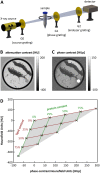Quantitative Three-Dimensional Imaging of Lipid, Protein, and Water Contents via X-Ray Phase-Contrast Tomography
- PMID: 27003308
- PMCID: PMC4803315
- DOI: 10.1371/journal.pone.0151889
Quantitative Three-Dimensional Imaging of Lipid, Protein, and Water Contents via X-Ray Phase-Contrast Tomography
Abstract
X-ray phase-contrast computed tomography is an emerging imaging technology with powerful capabilities for three-dimensional (3D) visualization of weakly absorbing objects such as biological soft tissues. This technique is an extension of existing X-ray applications because conventional attenuation-contrast images are simultaneously acquired. The complementary information provided by both the contrast modalities suggests that enhanced material characterization is possible when performing combined data analysis. In this study, we describe how protein, lipid, and water concentrations in each 3D voxel can be quantified by vector decomposition. Experimental results of dairy products, porcine fat and rind, and different human soft tissue types are presented. The results demonstrate the potential of phase-contrast imaging as a new analysis tool. The 3D representations of protein, lipid, and water contents open up new opportunities in the fields of biology, medicine, and food science.
Conflict of interest statement
Figures




References
-
- O’Sullivan A, O’Connor B, Kelly A, McGrath M (1999) The use of chemical and infrared methods for analysis of milk and dairy products. Int J Dairy Technol 52(4):139–148. 10.1111/j.1471-0307.1999.tb02856.x - DOI
-
- Colmenero F, Barreto G, Mota N, Carballo J (1995) Influence of protein and ft content and cooking temperature on texture and sensory evaluation of bologna sausages. Lebensm Wiss Technol 28(5):481–487. 10.1006/fstl.1995.0081 - DOI
-
- Janhoj T, Peterson C, Frost M, Ipsen R (2006) Sensory and rheological characterization of low-fat stirred yogurt. J Texture Stud 37:276–299. 10.1111/j.1745-4603.2006.00052.x - DOI
Publication types
MeSH terms
Substances
LinkOut - more resources
Full Text Sources
Other Literature Sources
Medical

